Say it after me: Genetics is fun! Wheeeeeeeee!
…..no, no it’s not lol. It’s confusing and tricky and sneaks surprises in 13 generations later. The only fun part is …cute babies!
I love to read, so when I was recently looking for another book that might help explain some rabbit genetics I kept seeing recommendations to buy this book, ABC About Bunny Colors. So I did! Turns out it’s authored by an Ellyn Eddy, although it doesn’t say that on the cover anywhere.
It arrived and is a self published POD (Print on Demand) style. In my experience the bindings don’t last as long if it’s a book you want to lay flat, so if you have a local copy shop that can cut the edge off and spiral bind I recommend that as this is the type of book you’ll need to stare at a page for a long time.
It was recommended as a “so easy!” genetics book that’s been around a while. As I’m reading the covers, I see that the tagline is “You shouldn’t have to be a nerd to be a rabbit breeder”. Right here…first negative.
First off, that’s insulting to nerds. Nothing wrong with nerds. Second…yea, if you have to insult someone to sell books you lose points in my eyes.
Moving past the cover…I started in. It does start with an easy to follow style and presents the information simply…well, it tries to. There’s a huge miss by using barely different sizes of images to represent the different sets of genes. The theory of using pictures vs the typical ABCDE is great, but I had a hard time telling the different sized trophies or square floral designs apart. I got where the author was coming from, but perhaps different colors vs sizes would’ve worked better.
The first few pages are indeed easy to follow. Simply written. Using the pictures does make for some weird formatting as some lines are double spaced and some single, but that’s a minor thing. Then, by page 13, it starts changing tone and moving away from the easy to understand into regular normal genetics talk.
Once Chapter Two gets going, now we’re out of easy and into “this will melt your brain”. The author tries to keep it light with some asides and doing “fun” titles for the sections…but, it’s not an “easy” explanation after this. This continues through the rest of the main body of the book. However, the chapters are well written and there is a ton of information on each color/gene/locus etc.
At the end, there is then a glossary of terms used, and an appendix of genotypes of common varieties- one of the best parts!. Then another appendix with some color name alternates and what breed uses them, which is another of the best parts especially when I raise two different breeds that like to make things complicated.
Overall…this is not as it’s advertised, an easy to understand genetics book, with the exception of the first chapter. It is a great reference for someone wanting to learn genetics and has a lot of in depth information on each set of genes (although it skips over some of the oddball chinchilla genes, it’s honest about it). I wouldn’t call it a practical guide, and yes, you DO need to be a little bit of a nerd to understand genetics the way it is presented.
To be fair, genetics isn’t easy. I’ve been looking for a “breed this get that” information source and unless you’re doing REW (Red Eyed White) to REW breedings , genetics won’t let that happen !
Do I recommend buying this book? Yes, but be prepared that you will need to digest it in chunks…repeatedly… and it’s not the easy spoon fed tome people make it out to be.
SM























